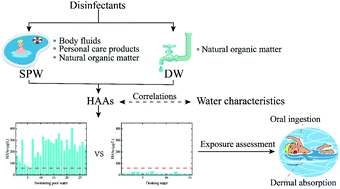Environmental occurrence and risk assessment of haloacetic acids in swimming pool water and drinking water
Abstract
A prevalent group of disinfection by-products (DBPs), i.e., haloacetic acids (HAAs), have raised significant public concern due to their high frequency of occurrence, considerable concentrations and potent toxicity. This study investigated the environmental occurrence of HAAs and the corresponding predicted human exposure to two important water matrices where humans are frequently and long-term exposed, i.e., swimming pool waters (SPWs) and drinking waters (DWs), in Shanghai, China. The sum of five HAAs in SPWs was 241 μg L−1 on average (dominated by dichloroacetic acid (DCAA) and trichloroacetic acid (TCAA)), four times as much as its maximum contaminant level (MCL) regulated by the Environmental Protection Agency (EPA) in DWs. The maximum HAA concentration in DWs was 35 μg L−1, with chloroacetic acid (CAA) as the most dominant compound. The higher concentrations (reflected by total organic carbon (TOC), dissolved organic carbon (DOC), and UV254) and more categories (body fluids and personal care products in addition to natural organic matter) of organic contaminants and the higher chlorine in SPWs should be responsible for the differentiated HAA yield and speciation. The qualification rates of samples have been evaluated. The power function models correlating HAAs with multiple water quality parameters were developed with correlation coefficients of 0.614 and 0.798 for SPWs and DWs respectively. These models may provide the preliminary insights on how to minimize HAA formation by grasping the relative importance of each parameter and how to build the framework to predict HAA formation in untreated source water or SPWs subjected to chlorination. The predicted carcinogenic and non-carcinogenic risks of humans exposed to SPWs and DWs with HAAs were within the acceptable levels.



 Please wait while we load your content...
Please wait while we load your content...